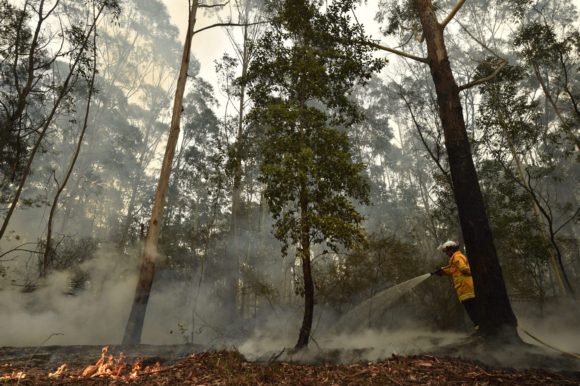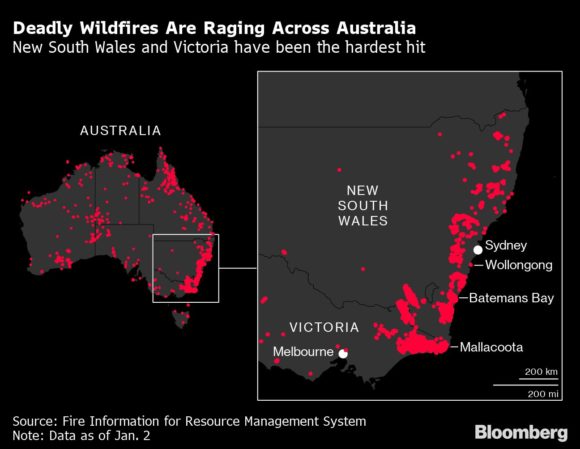Exhausted firefighters welcomed cooler weather and patchy rain in blaze-ravaged southeastern Australia Monday after a calamitous few days, even as authorities warn of a return to dangerous conditions later this week.
With no end in sight to the months-long crisis, authorities are counting the cost after the weekend saw properties in small towns on the south coast of New South Wales and alpine villages in neighboring Victoria state razed by fires that grew so large they generated dry thunderstorms. Thousands of people have been evacuated to recreation grounds hastily converted into makeshift camps that are shrouded in toxic smoke.
“There is no room for complacency, especially since we have over 130 fires burning across the state still,” New South Wales Premier Gladys Berejiklian told reporters in Sydney on Monday. She said that two more people were missing on the state’s south coast; the national death toll since the fire season began unseasonably early in September has risen to 24.
Prime Minister Scott Morrison has faced criticism for his belated response in pooling national resources to combat the fires. On Monday he again signaled his conservative government won’t toughen policies to combat climate change, which has been blamed for exacerbating a crippling drought that’s helped create tinderbox conditions.
On Saturday he announced an unprecedented level of military support to boost firefighting and recovery efforts, while on Monday after an emergency meeting of cabinet he said his government will commit A$2 billion ($1.4 billion) over two years to assist recovery efforts, focused on repairing infrastructure and boosting mental-health care.
“Today’s cabinet was one of great resolve,” Morrison told reporters in Canberra. “It was one where we stood together and said, whatever it takes, whatever it costs, we will ensure the resilience and future of this country and we will do it by investing in the work that needs to be done.”
Asked whether government relief funding and lost revenue due to the fires could jeopardize the government’s promise to return the budget to surplus this fiscal year, Morrison said the surplus wasn’t a focus compared to dealing with the human cost of the crisis. He said the economy’s position of strength was allowing the government to adequately respond to the disaster and its economic implications.
Hard Hit
Canberra, an inland city of about 500,000 people, has been one of the hardest hit by the smoke haze that’s shrouded southeast Australia for weeks. Early on Monday, the capital again had the world’s worst air quality, conditions which at the weekend prompted the release of about 100,000 particulate-filter masks from the national stockpile.
There’s little improvement expected in conditions that have already caused the cancellation of dozens of flights as well as postal services. On Monday, child-care centers were closed and shops and museums shuttered. The Department of Home Affairs has closed its Canberra offices until at least Wednesday, with non-essential staff told to stay home.
The hazardous smoke on Monday reached Melbourne, the largest city in Victoria. Australia’s navy was deployed at the weekend to rescue hundreds of stranded holiday-makers in the state who had been forced to huddle on the beach at Mallacoota as a ferocious blaze bore down on the tourist town last week.
About 200 homes have been destroyed in Victoria, and four people are still missing in the state. An airlift evacuation of 300 people from Mallacoota on Monday had to be delayed due to thick smoke.
Key authorities in New South Wales and Victoria welcomed the weekend news of the deployment of as many as 3,000 army reservists, but voiced disappointment that they weren’t consulted ahead of the decision or briefed before Morrison detailed his response plans to the media.
A 50-second advert about the deployment by Morrison’s Liberal Party was widely criticized for appearing to opportunistically politicize the crisis. It’s another misstep by Morrison, who was lambasted for taking an unannounced pre-Christmas vacation to Hawaii amid the crisis, and was filmed turning his back on a pregnant woman appealing for more resources to tackle the blazes as he toured a bushfire-ravaged community.
The unfolding tragedy, that’s blackened almost 5 million hectares (12.3 million acres) in New South Wales state alone, has prompted millions of dollars of donations and support from international celebrities, sports stars, and the British Royal Family.
New Zealand-born actor Russell Crowe, who is in Australia to protect his properties, had a statement read to the audience when he won an award at the Golden Globes in Los Angeles.
“Make no mistake, the tragedy in Australia is climate change-based,” Crowe said in the statement read by actress Jennifer Aniston. “We need to act based on science, move our global workforce to renewable energy and respect our planet for the unique and amazing place it is. That way, we all have a future.”
The resource-rich state of Western Australia will be completely cut off by road from the rest of the nation on Monday as fires and flood force the closure of main access routes, the West Australian newspaper reported. As well as the blazes that have affected major roads for weeks, the only highway out of Broome is due to close later Monday as Tropical Cyclone Blake bares down on the northwest coast.
On Saturday, two people died in wildfires that destroyed more than a third of South Australia’s Kangaroo Island, devastating the national park and farmland, and severely damaging the luxury Southern Ocean Lodge resort. Penrith, on the outskirts of Sydney, reached a record 48.9 degrees Celsius (120 degrees Fahrenheit) Saturday, symbolic of the dangerous weather conditions that have fanned ferocious flames and sparked new blazes further south.
While Berejiklian said conditions weren’t expected to worsen to those levels in coming days, there are fears two huge fires in the southern highlands could merge to become a “mega blaze.”
Berejiklian said her state was in “uncharted territory” due to the length and severity of the fire season. An estimated 60 homes were destroyed in New South Wales at the weekend, meaning more than 1,400 houses have been lost since September.
“The weather activity we’re seeing, the extent and spread of the fires, the speed at which they’re going, the way in which they’re attacking communities who’ve never ever seen fire before, is unprecedented,” Berejiklian said on Sunday.
–With assistance from Jason Gale.
Photograph: A firefighter tackles a bushfire south of Nowra on Jan. 5, 2020, when the death toll from the long-running crisis rose to 24. Photo taken by Peter Parks / AFP via Getty Images.
Related:
- Update: The Escalating Costs of Australia’s Wildfire Disaster
- Australia Breaks Records for High Temperatures, Low Rainfall as Wildfires Keep Raging
- Australia’s Wildfire Crisis Intensifies as Locals, Tourists Seek Refuge on Beaches
- Thousands of Tourists Evacuated as Wildfires Sweep Through Southeast Australia
Was this article valuable?
Here are more articles you may enjoy.




 Expense Ratio Analysis: AI, Remote Work Drive Better P/C Insurer Results
Expense Ratio Analysis: AI, Remote Work Drive Better P/C Insurer Results  Billionaire NFL Owner Suing Over Billboards Near His LA Stadium
Billionaire NFL Owner Suing Over Billboards Near His LA Stadium  Court Orders Justice Family Coal Companies to Pay $1M to Liberty Mutual Unit
Court Orders Justice Family Coal Companies to Pay $1M to Liberty Mutual Unit  Experian: AI Agents Could Overtake Human Error as Major Cause of Data Breaches
Experian: AI Agents Could Overtake Human Error as Major Cause of Data Breaches 

